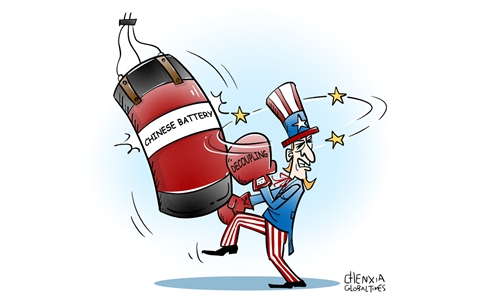
Illustration: Tang Tengfei/GT
China's Ministry of Industry and Information Technology (MIIT) revealed an initiative in early 2024 to promote fast development of the "future industries" or strategically important emerging industries. Recently, the ministry set up a new administrative body named "Department of Future Industries," which indicates that Chinese policymakers have set their eyes on fostering future-oriented drivers of economic growth.The institutional set-up isn't a small move as China aspires to rapidly develop "new quality productive forces," and lead the world in new technology innovation. China does not want to lag behind others in all important technology domains in the future.
Policymakers are telling the 1.4 billion Chinese people that high technology must be self-developed and secured, because "high-tech cannot be bought." The US government's relentless assault and squeeze on Chinese high-tech sector in recent years is the testament to this conviction.
The MIIT's new initiative set targets on facilitating future manufacturing, future information technology, future materials, future energy, future aerospace growth, and future healthcare development. The six fields resonate well with the Chinese government's resolve to foster "new quality productive forces" in its bid to replace traditional economic movers with newer, more dynamic and potent growth drivers.
Whether the new initiative will succeed has a close bearing to the sustainability of China's economic revival in the aftermath of the pandemic-induced downward pressure. To put it more succinctly, the initiative pertains to the competitiveness of China's sprawling manufacturing sector, and determines whether the country could prevail in future industrial and technological competition.
Over the past several years, some Western media pundits dangled silly suggestions that China's good days were numbered as its economy, dragged down by the real estate sector, "is walking into a dead end." Some even laughed that the US government's crackdown of Chinese high-tech companies would destroy and obliterate China's ability to compete with the US in the future.
But these pundits have failed to realize the resilience and creativity of Chinese people. The successful endeavors by China to facilitate future-oriented "new quality productive forces" in the past several years is being showcased by the country's meteoric rise in new energy, aerospace, robotics, 5G-led information industry revolution, high-speed commuting and transportation and more.
Taking battery and electric vehicle (EV) manufacturing for example, China is now clearly leading the world in innovation and market size. Of the world's total EV sales of around 13 million in 2023, China has sold 8.8 million, according to data provided by the China Passenger Car Association. The association has projected that EV sales will likely top 11 million units in China in 2024, with the domestic EV penetration rate to reach 40 percent, which is unrivalled in the world.
The new-energy sector, by all metrics, is one of the prime "future industries" that is shoring up China's technological edge and sustaining the country's advanced manufacturing.
The world's new-energy transition is unstoppable and will only gain pace, because it is a "sunshine" sector, fitting perfectly in the global fight to control carbon dioxide emissions and mitigate climate change. According to the International Energy Agency (IEA), EVs are the key technology to decarbonize road transport, which accounts for nearly one-fifth of global emissions. Few areas in the world of clean energy are as dynamic as the EV market, and China, undoubtedly, is the frontrunner of this new burgeoning industry.
Lately, Chinese policymakers have listed the "low-altitude" sector as another strategically important "future industry." Currently, Chinese provinces are ramping up efforts to accelerate growth of this new sector.
Chinese economic policymakers and analysts agree that the "low-altitude" economic sector refers to a spectrum of business activities occurring within the low-altitude space, from the surface up to 1,000 meters above the ground. The industry will encompass manned and unmanned civilian aircraft and flying vehicle activities, including aerial tourism, cargo delivery, eVTOL (electric vertical takeoff and landing) equipment manufacturing, maintenance and integrated service systems.
Many Chinese cities and provinces are studying how low-altitude activities can complement and facilitate development of other sectors such as agriculture, tourism, medical care and new business models. A number of other strategically important emerging sectors like robotics and artificial intelligence (AI) will also be vigorously developed in the course of developing the "low-altitude" economy.
China is endowed with sufficient conditions to develop the "low-altitude" economy. For example, the homegrown C919 jetliner provided the local aviation industrial chains with more knowledge about aircraft engineering, safety, and airworthiness. Meanwhile, the BeiDou Satellite Navigation System and China's expansive 5G network rollout will greatly facilitate the development of the low-altitude sector.
As to the development of eVTOL tools, China's dynamic EV sector will bring rich know-how in making high-density batteries, high-reliability motors, electronics control and autonomous driving. For example, Shenzhen, a special economic zone in South China's Guangdong Province, has vowed to build more than 600 takeoff and landing platforms for low-flying aircraft, and open more than 220 inner-city UAVs (unmanned aerial vehicles).
The size of China's low-altitude economy as of the end of 2023 was estimated at more than 500 billion yuan ($70 billion), and that scale is expected to expand to reach 2 trillion yuan by 2030, according to the Civil Aviation Administration of China, the regulator. The emerging industry will also become a motivator and catalyst to the growth of other sectors in China by creating new business patterns, new jobs and generating new revenue streams.
Clearly, Chinese policymakers have turned to nurturing strategically important future industries as the source to sustain the country's high-quality growth, and the only effective way to weather suppression and obstruction by others. That vision has revealed China's new development paradigm to reshape a new era of global competition.
The author is an editor with the Global Times. bizopinion@globaltimes.com.cn



